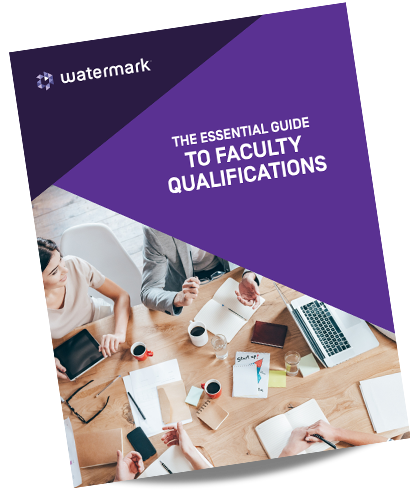There’s a hot topic on campus: faculty qualifications, or what accrediting bodies often call credentialing. While the vast majority of faculty are qualified to teach based on their academic degrees, some faculty (particularly adjuncts or those in health sciences or business) may be qualified based on work experience, licenses, certifications, or other qualifying activities.
Here’s what you need to know about credentialing, from what accrediting bodies mean by it to approaches to documenting and defending your faculty’s qualifications.



All of the regional accrediting bodies speak to the concept of a “qualified” faculty. Some accreditors provide detailed explanations of what constitutes a qualified professional while others are more vague. Accrediting bodies vary in how detailed they want institutions to be as they document and report faculty credentials. For some regional and professional accrediting bodies, a list of faculty and their terminal degrees may be sufficient, while others require much more detail. The Southern Association of Colleges and Schools Commission on Colleges (SACSCOC) is generally viewed as the most detailed in its specified requirements, and the Higher Learning Commission (HLC) region has also provided a great deal of guidance on the guidelines for faculty credentialing.
Historically, the primary way for a faculty member to be considered qualified has been an academic credential (i.e., you are qualified to teach Molecular Biology because you have a Ph.D. in that field). However, in a changing world, more and more institutions and the bodies that accredit them are recognizing that experience, research and other types of training can be just as compelling and rigorous a reason as a formal credential.
While the majority of your faculty are likely still qualified based on their terminal degrees, as these other justifications and experiences come into play, it becomes vital that institutions create appropriate policies, processes, and documentation of how they determine appropriate qualifications for their teaching faculty.


REGIONAL ACCREDITOR |
QUALIFICATION STANDARD |
|
| Higher Learning Commission (HLC) | 3.C.2 All instructors are appropriately qualified, including those in dual credit, contractual, and consortial programs. |
|
| New England Commission on Higher Education (NECHE) | 6.3 The preparation and qualifications of all faculty and academic staff are appropriate to the nature of their assignments. Qualifications are measured by advanced degrees held, evidence of scholarship, advanced study, creative activities, and teaching abilities, as well as relevant professional experience, training, and credentials. | |
| Middle States Commission on Higher Education (MSCHE) |
3.2.B. An accredited institution possesses and demonstrates student learning experiences that are designed, delivered, and assessed by faculty (full-time or part-time) and/or other appropriate professionals who are qualified for the positions they hold and the work they do. |
|
| Southern Association of Colleges and Schools Commission on Colleges (SACSCOC) |
6.2.A. For each of its educational programs, the institution justifies and documents the qualifications of its faculty members. |
|
| Western Association of Schools and Colleges (WASC) | 3.1 The institution employs faculty and staff with substantial and continuing commitment to the institution. The faculty and staff are sufficient in number, professional qualification, and diversity to achieve the institution’s educational objectives, establish and oversee academic policies, and ensure the integrity and continuity of its academic and co-curricular programs wherever and however delivered. | |
| Northwest Commission on Colleges and Universities (NWCCU) | 2.F.4 Consistent with its mission, core themes, programs, services, and characteristics, the institution employs appropriately qualified faculty sufficient in number to achieve its educational objectives, establish and oversee academic policies, and assure the integrity and continuity of its academic programs, wherever offered and however delivered. |
Given the range of expectations from regional accrediting bodies, plus the requirements of professional accreditors, is it better to take a high-level, overview approach, or get into the details of individual courses? We’ve worked with institutions across regions to develop a framework for credentialing that should allow you to provide the qualification information needed to satisfy any accreditor.
“One of the things that’s valuable about Digital Measures by Watermark is that faculty see the data, and they have an interest in ensuring it’s correct. The more you let the sun shine on data, the more accurate it gets and the more useful it becomes.” – Ray Whiting Associate Vice President for Project Management and Special Educational Initiatives, Augusta University
Institutions like yours from across accrediting regions have reviewed and confirmed that this framework allows them to satisfy their accrediting body.
This approach is easier, but less detailed. You’ll document faculty’s education, licenses, certification, and scheduled teaching, then provide a method to capture “additional qualifications,” such as a text box. The additional information is then available in a consistent format for use in reporting. This information is then reviewed by someone from the Office of Accreditation, the dean’s office, or a peer reviewer, who can determine if they align.
This approach requires significant upfront work to populate the information, plus ongoing work to maintain your dataset.
To use the course-level approach, you’ll need:
The first time I tried out the faculty qualification report, with literally three clicks, I got what I needed. It was like a wonderful gift—the time savings, but also the report presentation. It really transforms how you can get information. As an institution, we have to show our processes are working and show our outcomes. Rather than write a description of what we do, we can now elevate it to an argument based on analysis of data.” – Jan Smith Assistant Vice President for Institutional Effectiveness, Pittsburg State University
Whether you take the basic or course-level approach, you’ll need to define your internal process for determining qualifications. It is important to identify the person (or persons) at your institution who is responsible for reviewing and updating this information. At some institutions this may be a single person in an Office of Accreditation, while at others, deans or department chairs may be responsible. No matter how you assign this responsibility, you will want to have a single person who can help ensure the information is being correctly entered and kept up to date.
Addressing these questions is essential. If you don’t have a well-defined process or it isn’t sustainable, it won’t live up to the requirements of peer reviewers from your regional accreditor.
It takes a good deal of effort to capture and maintain the information needed for course-level credentialing, so here are some factors to consider when deciding.
If your institution falls into one of these categories, consider course-level credentialing:
Course-level credentialing is a substantial undertaking. As a benchmark, be prepared to dedicate someone essentially full-time during implementation, and consider keeping someone at least partially dedicated on an ongoing basis to maintaining and updating information.
All others should consider taking the basic approach.
The basic approach is a good choice if:
SCHEDULE A CREDENTIALING CONSULTATION
The way your institution documents faculty qualifications will depend on the level of detail needed to satisfy accreditors and other stakeholders. We’re here to help. Contact us today for free a credentialing consultation.
The Classification of Instructional Programs (CIP) provides a taxonomic scheme that supports the accurate tracking and reporting of fields of study and program completions activity. CIP was originally developed by the U.S. Department of Education’s National Center for Education Statistics in 1980. For example, “Anatomy” has the six digit code of 26.0403, which places it in “Cell/Cellular Biology and Anatomical Sciences (26.04) and “Biological and Biomedical Sciences” (two-digit CIP 26).
Some institutions may wish to use this classification as a way to easily match faculty academic degrees with the courses they are teaching. While this may be possible, consider the following cautions:
All of the potential issues noted here may add to confusion for faculty, administrators, and peer reviewers rather than reduce it. Although CIP codes are widely used for education surveys and statistics, they aren’t generally known or used outside of the Registrar’s Office and Institutional Research Office. In general, while utilizing CIP codes in this way may give you a good “start” to your documentation and process needs or provide an excellent backup, they won’t solve the problem of how to account for non-degree qualifications and they aren’t a guaranteed solution.
Watermark empowers better learning with solutions for assessment and accreditation management,
ePortfolios, course evaluation and institutional surveys, faculty activity reporting, and curriculum and catalog management. Serving over 1,700 institutions worldwide, we help institutions develop an intentional approach to learning and improvement based on data they can trust.

See how our tools are helping clients right now, get in-depth information on topics that matter, and stay up-to-date on trends in higher ed.